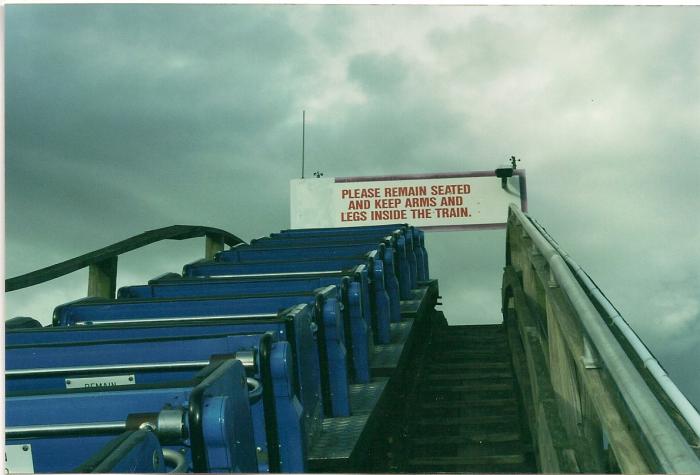
This ride has a control system known as the "PLC" which is designed as a back up to you, the operator, to take care of most emergencies and operator errors. However, it should always be remembered that the control system is a back-up and not a substitute for careful, attentive operators. Never rely on the system completely always be ready, and react immediately.
The PLC safety system operates by constantly sensing the position of the train (s) on the ride at all times and makes preprogrammed decisions based on train position and operator input. These decisions take the form of electrical outputs which either allow or disallow certain actions ranging from brake release to lift motor run permission.
1. Train Detection
The train is sensed by means of proximity switches (limit switches) mounted around the track which are activated by metal strips located under the train on the left side of the front car and on the right side of the rear car.
Under every car there is a separate metal strip used to activate the speed sensors SS located in the braking zone.
There is also a metal strip mounted on the right rear side of train #1 and left rear side of train #2. These trip limit switches 1LS (limit Switch) and 2LS which are the train identification switches.
2. Definition of Blocks
The control system through the use of proximity switches activated by the front or rear of the train, divides the track into three major or primary control blocks. These primary blocks are:-
(a) Block A
The first section or "Block A" begins just beyond the dispatch brake and ends at the top of the lift. It is activated as the first train leaves the station causing the "Block A Occupied" light to illuminate on the panel. Control over the dispatch brake will return to the operator when the train is half way up the lift. The first train will go over the lift only if the second train has cleared "Block B".
(b) Block B
The second block, "Block B" is that section of track beginning at the top of the lift and ending just before the dispatch brakes. When the first train goes over the lift, the "Block A" occupied light will go out and the "Block B occupied" light will light up, When "Block B" is occupied, the system will prevent the second train from entering that block by stopping the lift before the train goes over.
(c) Station
The Station Block begins where the front of the train enters the station and when the rear of the train leaves the station.
(d) As another point to note with the limit switches is that they are redundent. If either one of the entering switches are activated, the block is considered occupied, however it takes activation of both exit switches to clear the block.
(e) To ensure proper spacing in the station area, several secondary or overlapping blocks are created.
These are:
(i) Loading At loading position to exiting the station.
(ii) Seperation Exiting the station to on the lift.
(iii) Transfer Switch track to on the lift.
3. Another section of the control system are the photo cells which prevent a train from going over the lift anytime a train is occupying the emergency brakes. Anytime a train is located on the emergency brake, the photo cell light beam will be broken, causing the "Emergency Brake Occupied" light to illuminate and the control system to stop the second train from entering Block B. The photo cells also prevent the lift from being started if occupied.
4. The low air pressure alarm is also part of the control system. When the "Air Pressure" light is extinguished you will receive an audible alarm signal which indicates a problem in the air system. Since the brakes are air controlled, the ride should be closed.
5. Braking System
The brakes are of the FIN type The braking zones are designated in the following order, coming into the station.
(i) Emergency - first two sets of brakes
(ii) Trim - next single brake
(iii) Ready - single brake just infront of station area.
(iv) Dispatch - two sets of brakes located in the station loading area.
(v) Transfer - one single smaller brakes located just ahead of the transfer section of track.
The emergency brakes and trim brake only are fitted with limit switches to indicate they are functioning correctly and have returned to the closed position.
The brakes open (released) and close (braking) using compressed air.
There is a back-up air network which comes in and closes brake when the primary air pressure to that brake falls below a preset level. The primary air pressure must be restored to normal before the brake can be released.
NOTE: It is important to emphasize that the control system is a backup and its function should not be taken for granted. You, the operator, must always be aware of the location of both trains and act accordinly.







